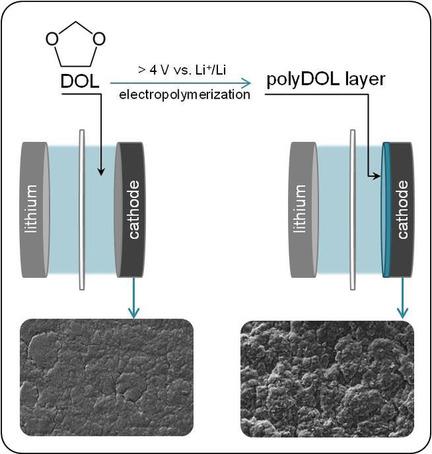当前位置:
X-MOL 学术
›
ChemElectroChem
›
论文详情
Our official English website, www.x-mol.net, welcomes your
feedback! (Note: you will need to create a separate account there.)
1,3‐Dioxolane: A Strategy to Improve Electrode Interfaces in Lithium Ion and Lithium‐Sulfur Batteries
ChemElectroChem ( IF 3.5 ) Pub Date : 2018-02-27 , DOI: 10.1002/celc.201701348 Andrea La Monaca 1 , Francesca De Giorgio 1 , Francesca Soavi 1 , Gabriele Tarquini 2 , Mariasole Di Carli 3 , Pier Paolo Prosini 3 , Catia Arbizzani 1
ChemElectroChem ( IF 3.5 ) Pub Date : 2018-02-27 , DOI: 10.1002/celc.201701348 Andrea La Monaca 1 , Francesca De Giorgio 1 , Francesca Soavi 1 , Gabriele Tarquini 2 , Mariasole Di Carli 3 , Pier Paolo Prosini 3 , Catia Arbizzani 1
Affiliation

|
Batteries with increased specific energy will play a crucial role in future electrical energy. Indeed, high specific energy means increased driving ranges in electric vehicles and can also improve the efficient use of the renewable energy. Lithium batteries, including lithium ion batteries (LIBs), with a high specific energy can be achieved with the use of high‐potential and/or high specific capacity cathodes. We exploit the ability of 1,3‐dioxolane (DOL) to polymerize at voltages higher than 4 V to produce a protective polymer layer in situ on two different cathodes. Specifically, DOL was polymerized on high‐voltage LiNi0.5Mn1.5O4 (LNMO) and on high‐capacity sulfur electrodes in order to reduce the electrode/electrolyte interface reactivity of these cathode materials and to improve cycling performance.
中文翻译:

1,3-二氧戊环:改善锂离子和锂硫电池电极界面的策略
比能量增加的电池将在未来的电能中发挥关键作用。实际上,高比能量意味着增加电动汽车的行驶里程,并且还可以改善可再生能源的有效利用。通过使用高电势和/或高比容量的阴极,可以实现具有高比能量的锂电池,包括锂离子电池(LIB)。我们利用1,3-二氧戊环(DOL)在高于4 V的电压下聚合的能力,以在两个不同的阴极上原位产生保护性聚合物层。具体而言,DOL在高压LiNi 0.5 Mn 1.5 O 4上聚合 (LNMO)和高容量硫电极上,以降低这些阴极材料的电极/电解质界面反应性并改善循环性能。
更新日期:2018-02-27
中文翻译:

1,3-二氧戊环:改善锂离子和锂硫电池电极界面的策略
比能量增加的电池将在未来的电能中发挥关键作用。实际上,高比能量意味着增加电动汽车的行驶里程,并且还可以改善可再生能源的有效利用。通过使用高电势和/或高比容量的阴极,可以实现具有高比能量的锂电池,包括锂离子电池(LIB)。我们利用1,3-二氧戊环(DOL)在高于4 V的电压下聚合的能力,以在两个不同的阴极上原位产生保护性聚合物层。具体而言,DOL在高压LiNi 0.5 Mn 1.5 O 4上聚合 (LNMO)和高容量硫电极上,以降低这些阴极材料的电极/电解质界面反应性并改善循环性能。











































 京公网安备 11010802027423号
京公网安备 11010802027423号